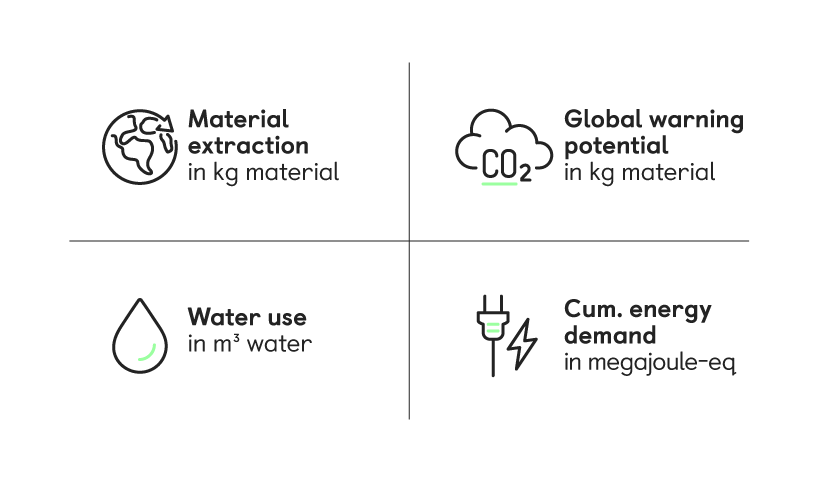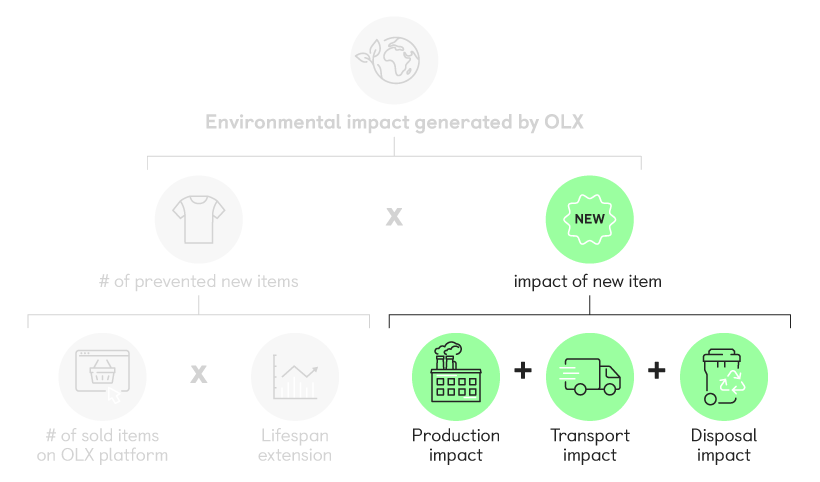
About our 2021 Impact Report
Our Impact Report looks at the amazing positive impact of secondhand trade.
Here we explain how we made the report, and the criteria behind it.
Product categories
Our report includes the below categories:
- Electronics: smartphones, tablets, laptops and televisions
- Cars
- Motorcycles
- Books
- Fashion
These categories were chosen because of their high volumes on our platforms, their tangibility, and their relevance in today’s sustainability debate.
Our markets
Our analysis was performed on a selection of geographical areas where OLX Group is active. As cars are sold on different OLX Group platforms, more countries were included.
For cars, our report includes 19 countries:
- Argentina, Bosnia & Herzegovina, Bulgaria, Chile, Colombia, Ecuador, India, Indonesia, Kazakhstan, Mexico, Peru, Poland, Portugal, Romania, South Africa, Turkey, Ukraine, Uzbekistan and the U.S. This includes the consumer brands OLX, OLX Autos, AutoTrader, Autovit, Otomoto, letgo, Standvirtual, and webuyanycar.com in the US.
For all other categories, our report includes 16 countries:
- Argentina, Bosnia & Herzegovina, Bulgaria, Colombia, Ecuador, India, Indonesia, Kazakhstan, Peru, Poland, Portugal, Romania, South Africa, Turkey, Ukraine and Uzbekistan. This includes the consumer brands OLX and letgo.
Standards used
Environmental inputs refer to data coming from lifecycle assessments (LCAs). All environmental inputs come from Ecoinvent, a renowned database for LCA’s. The impact of a LCA is given in a wide range of impact indicators. For this study, the four main indicators are used to quantify the environmental impact:

Scope and variables
To determine the impact of the different categories, we used as much primary data from the different OLX Group platforms as possible. We do not assume that every item on the platform actually gets sold.
We only consider an item reused on our platform if it had more than 3 replies on the listing for electronics, books and fashion. For vehicles, we assume an item is actually reused if the listing received more than 10 replies.
Our methodology
The research for our report was carried out by Rebel Group in the Netherlands.
The analysis is based on the premise that for every product that is sold via a second hand platform such as OLX, the buyer refrains from buying a new one, and the lifespan of the product is extended. Second hand platforms therefore prevent environmental impact.
How is this calculated?
OLX Group platforms facilitate the reuse of items, which stimulates an extension of the lifespan of an item. The environmental impact of OLX is calculated by multiplying the number of prevented new items with the environmental impact of a new item.
By extending the lifespan of an item, the production (and transport and disposal) of new items is prevented over time. This means that we do not assume that buying one item on OLX fully prevents the production of a new item. Instead, we look at the total lifespan of a product, and how many additional years of use could be added. While the calculation method is the same for each product in each country, the underlying inputs differ.
For each new item, the environmental impact is calculated by doing a lifecycle analysis (LCA). This consists of the following impacts:
- The production impact: the extraction of materials and the assembly of materials into a product;
- The transport impact: the transport of an item from the production location to its first user;
- The use impact: the impact of using an item, since the use of a new item is similar to the use of a second-hand item, the net impact of the use phase is assumed to be
- zero and is therefore not included in this analysis;
- The disposal impact: the impact of disposing an item by the first user.


Number of prevented new items
The number of prevented items is calculated by combining OLX sales data for each country and each product with the estimated lifespan extension of each product in each country.
Based on general inputs and publicly available sources, the lifespan extension per product per country is determined. The three components of this lifespan extension are:
- The first-user lifespan: the number of years the first owner uses the product.
- The total lifespan: The total number of years a product can be used for.
- Reuse rate: the number of times a product switches users. For cars, it is likely it changes owners more than once, which is less likely the case for smartphones.
To be conservative, we use a maximum lifespan extension of 100%.
Lifecycle assumptions
Smartphones
Mobile phones lifespans are mostly dependent on the subscription models in different countries and are trend-sensitive (i.e. innovations for smartphones, new releases etc). We thus model regional differences for mobile phones.
Tablets and laptops
The first user lifespan for tablets and laptops are less prone to consumer trends and more dependent on brand quality and frequency of use. We thus do not model regional differences in lifespans, but rather model differences based on brands. The first user lifespans per brand are assumed to be linked to warranty or update periods.
Televisions
Plasma and LCD televisions have different total lifespans before deteriorating, dependent on the usage. A Plasma TV can last up to 50,000 hours and a LCD TV up to 30,000 hours. The average amount of hours people spent watching television per country determined the total lifespan per country.
Vehicles: cars and motorcycles
The first user lifespan per country was measured using EU vehicle fleet data and datasets on life spans per continent.
Reuse rate: Seeing as cars and motorcycles are known to change hands more often, we cannot attribute all the additional years to OLX. We thus calculate using a reuse rate, which is the number of times a vehicle is resold during its total lifespan. We attribute only one of the rotations to OLX. We take a conservative approach for the reuse rate, with the assumption that a vehicle is reused 5 times in its lifetime on average.
Fashion
Based on studies on textile lifespans by Rebel, and external research reports the lifespan extension for garments was calculated.
Books
It is assumed that the prevented impacts of a book is simply one book. It is not expected that lifespan extension is the driver for the prevented environmental impact, but rather that when buying a book via OLX Group, it prevents having to buy a new book. We thus assume first user and second user lifespan are equal, and the prevented environmental impacts is 100% of the total impacts.
Lifecycle assumptions
To calculate the environmental impacts, we modelled the different steps in the lifecycle of the product, namely: production, transport of manufacturer to country and region of sale and end of life. We do not consider the use period as these are assumed to be equal users.

Production
To calculate the environmental impacts of first user production we modeled the products using the Ecoinvent life cycle inventory database. Where possible, we used the end product. All assembly steps and waste streams are included in the production impacts.
Production impact
For all products except fashion, the production impact is calculated by combining the below inputs:
- Weight per brand or type of product
- Environmental impact per kg of item (including materials and assembly)
- Environmental impact per kg of packaging
For fashion, the production impact is calculated by combining:
- Average weight per fashion category
- Average material composition per fashion category (% per material)
- Impact of each raw material per kg
- Impact of assembly (bleaching and dying) of all materials
Transport impact
For laptops and TVs, the impact of transport is already included in the impact data from Ecoinvent. For all other products, transport is divided into three sections:
- T1. transport from production location to the nearest port of export,
- T2. transport from the port of export to the main port of import in the country of the user,
- T3. transport from the main port of import to the first user.
The inputs used to calculate the impact per transport leg (T1-T3) are:
- Total weight of new items that is prevented in ton
- Average distance per transport leg in kilometers
- Environmental impact per transport mode in ton*km
To know where the products were shipped from, we look at the manufacturer information of the biggest brand of that product category. For example, for phones and tablets the largest manufacturer of items sold on our platforms is Apple, so we reviewed information on the supply chain of Apple that they have available online.
For fashion there are many production locations: China, the EU and Bangladesh, Vietnam, India, Turkey, Hong Kong, Indonesia, Cambodia and the USA (based on the World Trade Statistical Review 2019 by WTO). We modeled the main fashion production cities based on the weighted average distance of these countries.
For books, it is assumed that production locations are more regional due to printing houses often being located in the country itself. To be able to account for transport, we used the internal distance of a country between producer to consumer. It is assumed all internal distance traveled is done by lorry.
Disposal impact
For all products, the disposal impact is calculated by combining the inputs:
- Total weight of new items that is prevented (in kg)
- Split in disposal methods per product per country (% per method)
- Impact per disposal method per kg of treated ‘waste’.
Copyright: OLX Group 21 April 2022. All rights reserved.